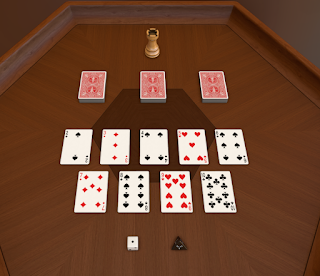console++ gives you live access to your mod's structure, treating it as if it were a file system. It lets you examine your variables, functions and objects, and also lets you update them, all without leaving the game.
 To follow along to this tutorial you need to get console++ from the link above and subscribe to the example mod on the Steam Workshop. Once you've loaded it into Tabletop Simulator, save it to your own hard disk so you can save your edits.
To follow along to this tutorial you need to get console++ from the link above and subscribe to the example mod on the Steam Workshop. Once you've loaded it into Tabletop Simulator, save it to your own hard disk so you can save your edits. Source code is visible here.
This post will cover navigating and displaying your program using the two basic commands in console++: 'ls' and 'cd'. As a quick aside, I'll be using the unix-like command names during this tutorial ('ls'), but console++ includes DOS-like alternatives, so if you prefer DOS you can use those instead. In this case, anywhere I say 'ls' you can type 'dir' instead.
What does 'ls' do? Well, we could ask for help on it, but lets do the impetuous thing and just type it into the console; make sure you are on the Game tab of the console, not the Global tab it defaults to (also it would be a good idea to hit the cog and disable autohide if you have it turned on).
So, hit enter, type 'ls' and hit enter again. Congrats, you just said 'ls'; the console is just the chat window after all, and you didn't tell it you wanted to use a command! To use a command you type the prefix '>' before it, so lets try again, typing '>ls'. Much more interesting, and if you looked at the source file above it should look a little familiar:
You can see the variables we defined in the source are there; the 'ls' command lists all the tables and variables in your current location. Right now we're in the root of our program ('/') which is the global level. You can see at the top of the listing some labels in yellow: these are tables. Let's see what's in them; type '>ls decks'. Nothing there? That's because by default the 'ls' command only displays tables and basic variables (numbers, strings and booleans); to get it to show game objects we need to use the '-o' option. Try '>ls decks -o' and you'll see:
There are our deck objects: table entries a, b, and c. We can see their GUIDs listed next to them; right click a deck on the table and check the Scripting submenu to see it matches up.
We can refer to each of these decks by their path: if you type '>ls decks/a' you'll get the listing for only deck a. Now, if we were debugging something to do with these decks, and were going to type their names a lot it would be tedious to have to keep specifying their location. Instead we can change our current location to suit our needs, with the 'cd' command. Type '>cd decks' and then '>ls -o'. As you can see we have changed the table we are in; we can now refer to the decks simply by their letters: '>ls a'. Note that when we specify an exact path we do not need the '-o' option.
Paths behave just as you would expect for a file-system; you can specify relative paths from your current location or absolute paths from the root table (by starting your path with a '/') You can refer to a parent table by using '..' and your current table with '.'
Let's go back to the root table: type either '>cd ..' to go up one level (we are only one level below the root) or '>cd /'. This example mod is clearly very small and simple, but you can imagine in a big game you will have lots of variables and tables; simply typing '>ls' and scrolling up and down looking for things could be cumbersome. In that situation it would be good to use a wildcard to trim down what you're looking at: try '>ls c*'
That's the basics of navigating and examining your program from within TTS with console++, except to return to what was said at the top of the post about asking for help: you can type '>help' or more simply '>?' to get help on any command, and the commands with more complicated options will also support a '-?' option to provide more detailed information. If you type '>? ls' you'll see it has a few options we haven't tried yet. To wrap up lets try '>ls -ar' ...
Next time we'll look at actually interacting with your program by modifying variables in real time.




No comments:
Post a Comment